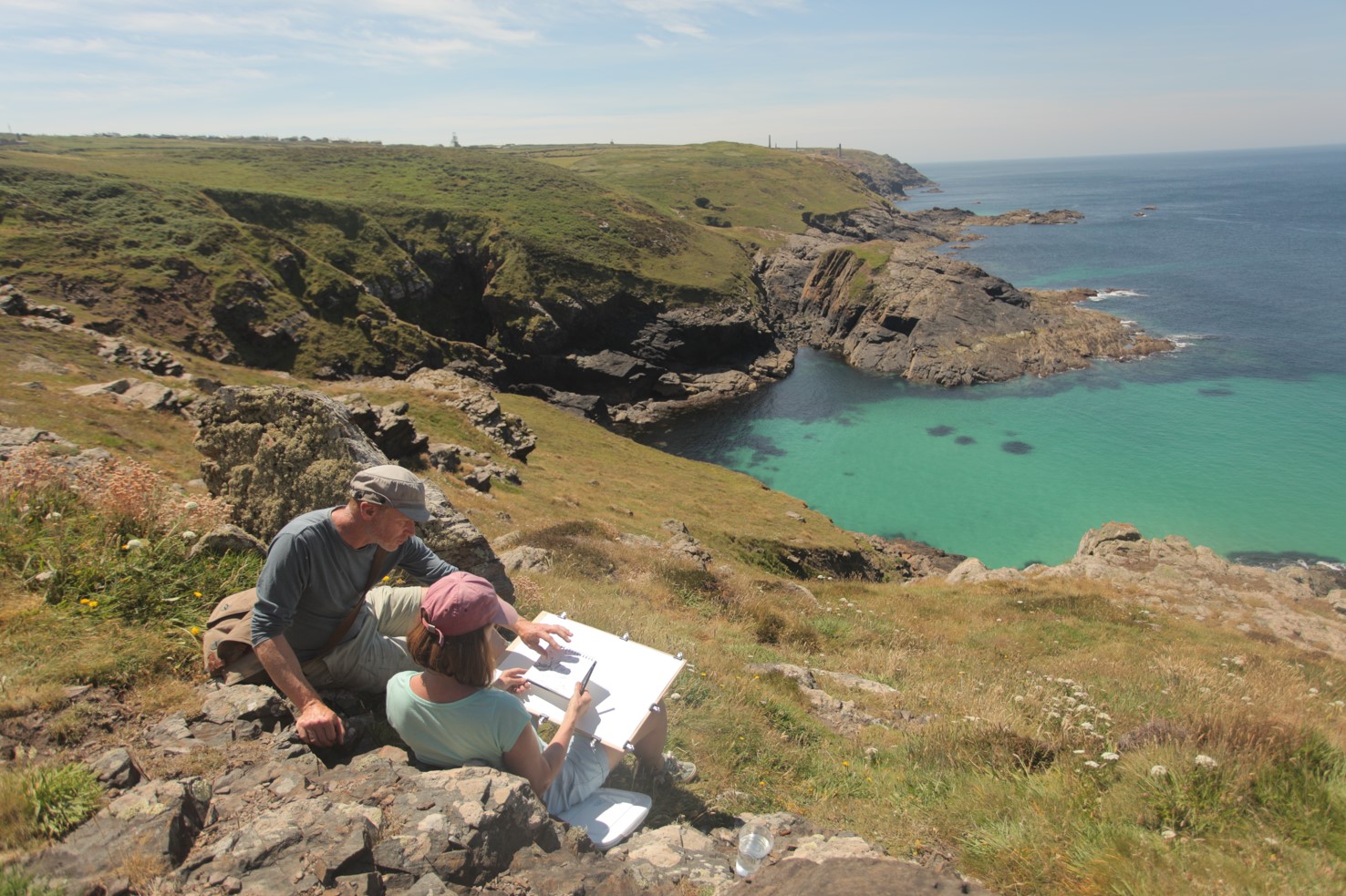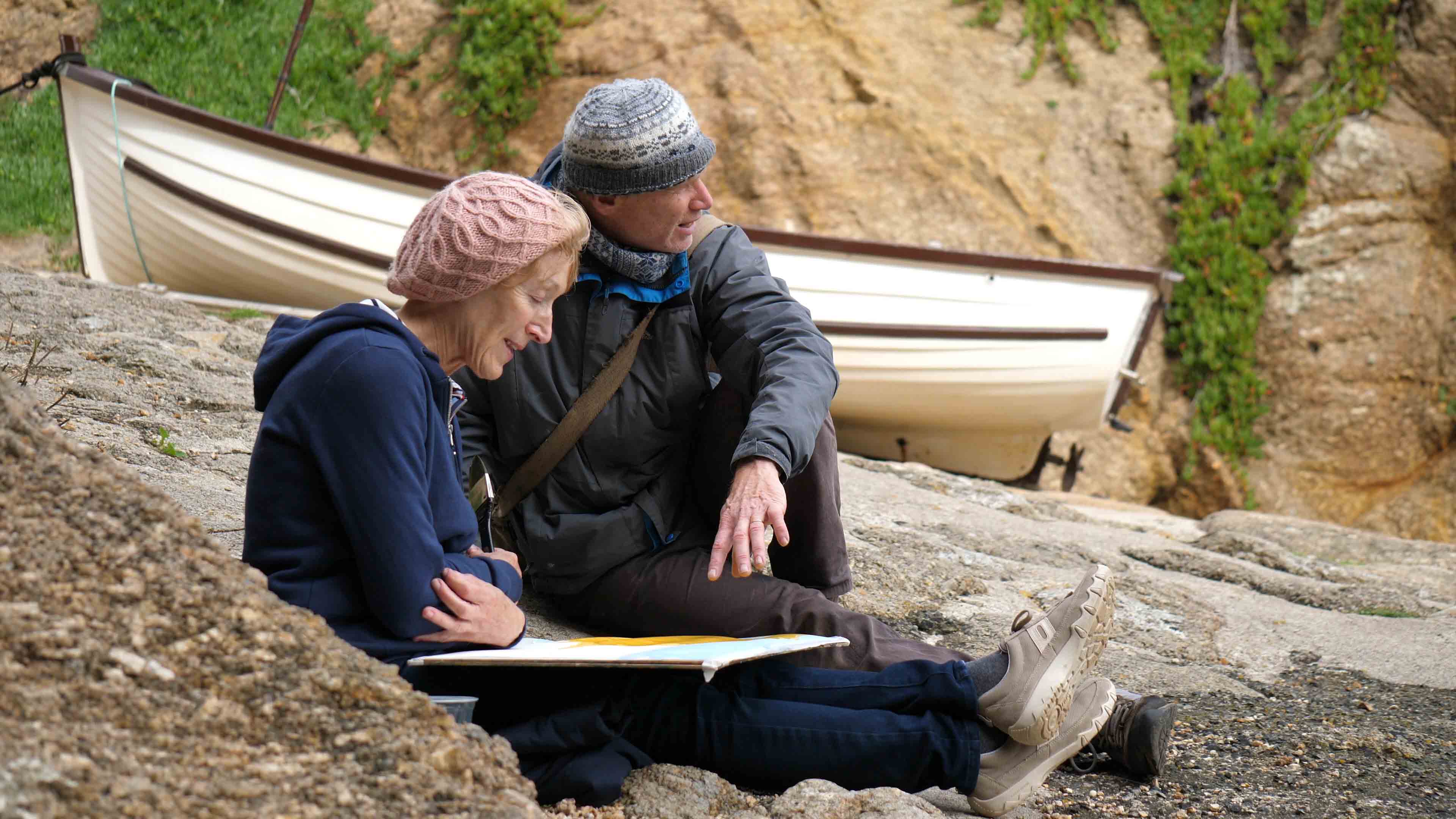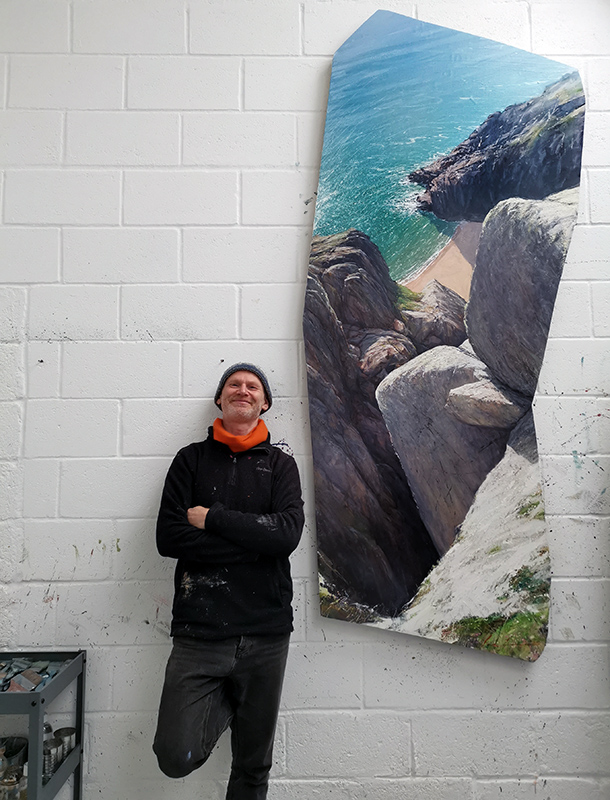When did Cornwall come into focus for you?
On the second year of my degree we had a week-long field trip to West Cornwall. I was immediately blown away by the landscape. I remember standing on the cliffs at Botallack – I had just never seen anything so powerful. It was my first serious experience of working outside and I did loads of drawing. I don’t think I realised at the time, but that was when I found my subject.
The drawings I created in that week ended up being some of the best from my whole three years at Bristol. The challenge of fighting against the wind and weather was so exciting and I became completely absorbed in what I was doing. So much so that when we were offered a private visit to spend half a day with Patrick Heron at his studio I chose to stay outside and keep drawing! Looking back, it was silly to miss an opportunity like that, but I guess it showed how inspired I felt.

How do you work with the constantly-changing weather and light of Cornwall when you’re painting on location?
I always finish a painting on location on the same day. When I’m painting outside I get drawn into a deep space of intense concentration and I just need to finish it. The weather and light would be completely different if I returned on another day. Sometimes it’s hard to finish a painting completely so I may take it back into the studio. If I have to do too much work on it though then I’m aware that the painting has probably failed. It is easy to polish a painting in the studio, but then it looks false, so I try not to do that.
These large oils I create completely in the studio. But I can only do that because I have spent so much time painting and drawing outside. I couldn’t do anything in the studio for the first ten years in Cornwall. Every time I tried it failed, because I didn’t have the visual memory or experience to pull it off. For me it’s about getting outside capturing the spirit of a place.
Hella Point, Portgwarra Mixed Media 57 x 77cm - Paul Lewin
Do you go out in all weather? If it’s blowing a hoolie and there’s horizontal rain do you think: ‘It’ll be a studio day then’?
Ha! I do make the effort to get out. There’s an edge to a painting done in stormy weather like that. It’s usually unfinished, but it is perfect in its own way. It’s the imperfections, the struggle, that is part of it.
There are some hilarious clips of me online that were filmed for The One Show. The BBC had been looking for an artist that was mad enough to paint in a storm, and they contacted me through Henry, who runs the Art School.
I arranged to meet them at Pendeen by the lighthouse and got there early to get some paint down before they came to film. It was an incredible day with bright sunshine and a wild sea, but I really struggled to find a spot where I wouldn’t get blown away! As the film crew arrived I could see this dark cloud coming in. Just as they started to interview me it started hailing. Force 8 hailstone were bouncing off my painting and hitting my face, it really hurt! I’m making up stuff because I can’t hear what the interviewer is saying, and I’m grinning because it seemed so ridiculous. The painting actually turned out really well though and I ended up getting something like twenty-five-thousand hits on my website the day it aired.
Do you have a particular process when going on location to paint?
My bag is always packed and ready by the door, ready to go. I’m very familiar and comfortable with my equipment so it feels very natural. The location I have in mind will depend on weather, time of year and wind direction, amongst other things. It’s this idea of a location that gets me out the door – but I often get distracted and end up somewhere else. And I’m open to that. You have to be open for chances of light – in a moment the sun can bring a scene to life and you just have to be there in the moment to experience that.
Then it’s basically just getting rid of the white paper and everything else comes from that. One mark leads to another, so your first mark will dictate the rest of the painting. I don’t like to say that to my students though because it makes them too self conscious!
How did you get involved with teaching at the Newlyn School of Art?
I’ve been teaching at the art school for about ten years now. When I first started I hadn’t done much teaching, so I was quite nervous. But it was actually really good for me. For the first time I had to put my own practice into words. It made me more conscious about how and why I paint and made me appreciate my skills. Teaching is a two-way thing. I’m not just giving all the time; I’m learning as well too, which I think is important. In my everyday surroundings I am alone a lot, whether I am in the studio or out on the cliffs, so I enjoy the interaction with other people that are interested in the same things; it provides a nice balance.
What is a key piece of advice you give your students?
You can’t be too precious. That’s the way my technique has developed. If you look closely at my paintings you’ll see that it’s just thrown paint and brushstrokes - almost abstract up close. There’s lots of changing of my mind and scraping back involved. But that in itself reflects nature. Nature isn’t perfect; it has all sorts of anomalies. The technique I use, which includes throwing paint, encourages randomness and chance to some degree and that helps to keep the paintings alive, and helps to keep me interested.
 Do the people that attend your course tend to have some experience of painting and drawing already?
Do the people that attend your course tend to have some experience of painting and drawing already?
Everyone from complete beginners to semi-professional artists come on my course. I do demonstrations, answer questions in the group and I always make sure that I spend time with each student individually. I want to make sure that everyone is going to get something out of it, whatever their previous experience.
I quite often find that there’s a nice mix within each group and those that aren’t sure what they’re doing can learn from their more-experienced companions too. It’s all part of it. I don’t expect everyone to come away with a Paul Lewin! Each person brings their own strengths. But I don’t think you can do paintings of the sea or landscape convincingly unless you’ve spent time experiencing it.
It can be quite intimidating for someone who has never painted outside to actually get started, but I show them everything, from which colours to bring with you, to what to pack in your bag and how to set yourself up when you get outside. I try to get the students out as much as possible, because simply being out in the landscape is where I learned everything. The more you do it, the easier and more natural it becomes.

Paul Lewin teaches on the three-day short course Seascapes and Landscapes, our online courses Seascape and Landscape Online and Year-long Online Landscape, as well as tutoring on our Tresco Painting Holiday.